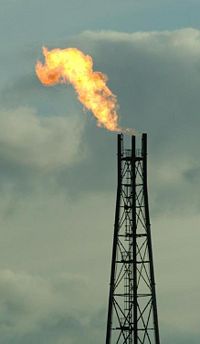Flare stack: Difference between revisions
imported>Milton Beychok m (Added a reference) |
imported>Milton Beychok m (Deleted a reference url) |
||
| Line 3: | Line 3: | ||
{{Image|Gas Flare.jpg|right|200px|A gas flare as used in the petroleum industry.}} | {{Image|Gas Flare.jpg|right|200px|A gas flare as used in the petroleum industry.}} | ||
A '''flare stack''' or '''gas flare''' is a tall vertical vent pipe used in [[Petroleum refining processes|petroleum refineries]], [[chemical plant]]s and [[petrochemical plant]]s, oil and gas drilling sites, [[Natural gas processing|natural gas processing plants]], and [[landfill]]s for burning off unusable waste gas or flammable [[gas]] released by pressure [[relief valve]]s during unplanned over-pressuring of plant equipment.<ref>{{cite book|author=John J McKetta, Editor|title=Encyclopedia of Chemical Processing and Design|publisher=Marcel Dekker|year=1985|pages=144|id=ISBN 0-8247-2491-7}}</ref><ref name=Beychok>{{cite book|author=Milton R. Beychok|title=[[Fundamentals of Stack Gas Dispersion]]|edition=Fourth edition|publisher=self-published |year=2005|id=ISBN 0-9644588-0-2}} | A '''flare stack''' or '''gas flare''' is a tall vertical vent pipe used in [[Petroleum refining processes|petroleum refineries]], [[chemical plant]]s and [[petrochemical plant]]s, oil and gas drilling sites, [[Natural gas processing|natural gas processing plants]], and [[landfill]]s for burning off unusable waste gas or flammable [[gas]] released by pressure [[relief valve]]s during unplanned over-pressuring of plant equipment.<ref>{{cite book|author=John J McKetta, Editor|title=Encyclopedia of Chemical Processing and Design|publisher=Marcel Dekker|year=1985|pages=144|id=ISBN 0-8247-2491-7}}</ref><ref name=Beychok>{{cite book|author=Milton R. Beychok|title=[[Fundamentals of Stack Gas Dispersion]]|edition=Fourth edition|publisher=self-published |year=2005|id=ISBN 0-9644588-0-2}} See Chapter 11, ''Flare Stack Plume Rise''.</ref><ref>[http://aiche.confex.com/aiche/s06/techprogram/P40539.HTM A Proposed Comprehensive Model for Elevated Flare Flames and Plumes], David Shore, Flaregas Corporation, [[AIChE]] 40th Loss Prevention Symposium, April 2006.</ref> | ||
==The purpose of flare stacks== | ==The purpose of flare stacks== | ||
Revision as of 16:35, 12 October 2009
A flare stack or gas flare is a tall vertical vent pipe used in petroleum refineries, chemical plants and petrochemical plants, oil and gas drilling sites, natural gas processing plants, and landfills for burning off unusable waste gas or flammable gas released by pressure relief valves during unplanned over-pressuring of plant equipment.[1][2][3]
The purpose of flare stacks
In petroleum refineries, chemical plants and petrochemical plants, oil and gas drilling sites,and natural gas processing plants, the main purpose of a flare stack is that of safety by protecting pressure vessels or pipes from over-pressuring due to unplanned upsets.
In landfills, the primary purpose of this device is to vent and/or burn waste gas which results from the decomposition of materials in the landfill.
How flare stacks work
Whenever plant equipment items are over-pressured, the pressure relief valves provided as essential safety devices on the equipment automatically releases gases (and sometimes liquids as well) which are routed through large piping runs called flare headers to the flare stacks. The released gases are burned as they exit the flare stacks. The size and brightness of the resulting flame depends upon the flammable material's flow rate in terms of joules per hour (or btu per hour).[2]
Most flares have a Vapor-liquid separator upstream of the flare to remove any large amounts of liquid that may accompany the relieved gases.
Steam is very often injected into the flame to reduce the formation of black smoke. In order to keep the flare system functional, a small amount of gas is continuously burned, like a pilot light, so that the system is always ready for its primary purpose as an over-pressure safety system.
Environmental impacts
The flaring and venting of assocated gas from oil drilling sites is a significant source of carbon dioxide (CO2) emissions. The amount of such emissions has declined from a peak of about 110×106 metric tons in the 1970s to 40×106 metric tons in 2005, a decrease of about 64 percent.[4]
The World Bank estimates that 150 billion cubic meters of raw natural gas are flared.[5] This flaring is highly concentrated: 10 countries account for 75% of emissions, and twenty for 90%.[4] The largest flaring operations occur in the Niger Delta region of Nigeria. The leading contributors to gas flaring are (in declining order): Nigeria, Russia, Iran, Iraq, Angola, Qatar, Algeria, Venezuela, Equatorial Guinea and Indonesia.[4]
References
- ↑ John J McKetta, Editor (1985). Encyclopedia of Chemical Processing and Design. Marcel Dekker, 144. ISBN 0-8247-2491-7.
- ↑ 2.0 2.1 Milton R. Beychok (2005). Fundamentals of Stack Gas Dispersion, Fourth edition. self-published. ISBN 0-9644588-0-2. See Chapter 11, Flare Stack Plume Rise.
- ↑ A Proposed Comprehensive Model for Elevated Flare Flames and Plumes, David Shore, Flaregas Corporation, AIChE 40th Loss Prevention Symposium, April 2006.
- ↑ 4.0 4.1 4.2 Gas Flaring Emission Contributes to Global Warming Lulea University of Technology (Sweden) and Institut National des Sciences Appliquées de Lyon (France)
- ↑ The World Bank
